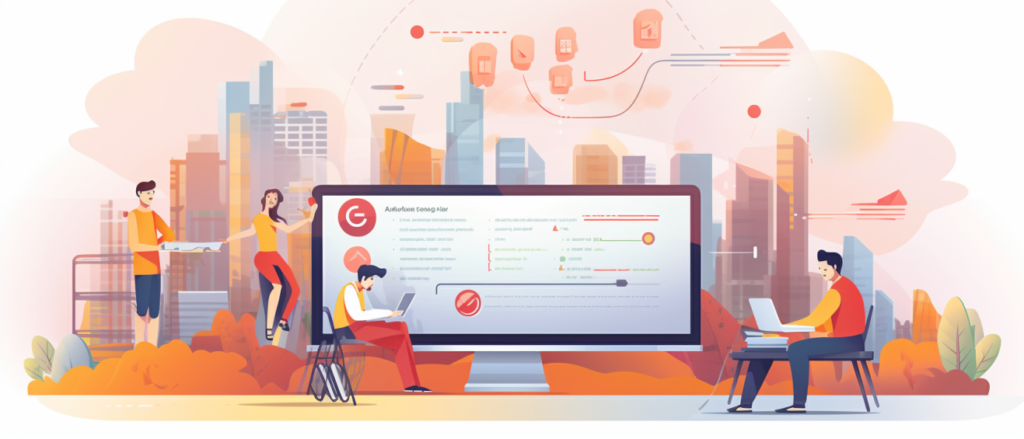Key Takeaways
✅ Segment Visitors to Understand Bounce Rate: Diving into analytics to breakdown bounce rates by visitor type can reveal a lot. Is traffic from social media sticking around less than from your newsletters? Segmenting can answer that and guide tailored strategies.
✅ Optimize User Experience to Reduce Bounce Rate: Every second counts. Shave time off your page load speed and watch visitor satisfaction climb. Quality content and an easy-to-navigate site are non-negotiables for keeping those potential customers around.
✅ Focus on Long-Term Engagement Over Bounce Rate: Nano-targeting your marketing efforts for instant clicks? Think bigger. Foster a space where visitors don't just land and leave but come back time and again. That's the real win.

Introduction
Have you ever wondered why some visitors leave your website without a trace, never clicking past the first page? With the growing importance of maximizing website usability and visitor segmentation, understanding these dynamics is more critical than ever. But here's something to chew on: a high bounce rate could be more a symptom than the disease itself.
In a world where first impressions are digital, knowing your visitors and giving them what they want in record time is not just good practice—it's essential for survival in the online jungle. We'll explore innovative strategies that go beyond traditional metrics, dissect modern trends, and provide valuable solutions for bumping up those conversion rates.
Stick around, because we're not just throwing numbers and theories at you. We're promising a treasure trove of actionable insights and game-changing info that's as practical as it is groundbreaking. Ready to revamp your site's appeal and keep those visitors coming back for more? Let's dive in.
Top Statistics
| Statistic | Insight |
|---|---|
| 47% of users won’t wait longer than two seconds for a website to load | The need for speed is paramount. E-commerce sites must prioritize loading times to avoid losing potential customers. |
| 73% of users have encountered a mobile website that loaded too slowly | This statistic serves as a stark reminder that mobile optimization is crucial for keeping visitors engaged and interested. |
| 57% of consumers will not recommend a website if it isn’t mobile-friendly | Word-of-mouth can make or break a website's reputation. A mobile-friendly experience encourages recommendations and recurring visits. |
| 88% of users with a positive browsing experience are more likely to return | Loyalty is a direct result of positive interactions. A seamless browsing experience turns first-time visitors into repeat customers. |
| 60% of users’ online time was spent browsing the web from their mobile phones | The mobile-first world is not a future scenario; it's already here. Businesses have to ensure their content is accessible on-the-go to retain visitor engagement. |
Understanding Bounce Rate and Its Impact
Bounce rate is a telling statistic about a webpage's effectiveness, measured by the percentage of visitors who land on a page only to leave without taking any further action. To calculate this, divide single-page sessions by the total number of sessions and then multiply by 100. If this figure is high, it raises a red flag that maybe you're not quite hitting the mark with your audience. A high bounce rate indicates that your content, design, or user experience might need improvement. Monitoring bounce rate can provide critical insights into how well your website is engaging visitors and meeting their needs.
Factors Affecting Bounce Rate
Why do visitors leave so promptly? The speed at which your page loads can play a pivotal role. We live in a fast-paced digital world where every second counts, and slow-loading websites are akin to a brick-and-mortar store with a line out the door. People are more likely to walk away. If your content isn't aligned with what they're searching for, or if they find the layout cluttered and confusing, the likelihood of them sticking around dims. Equally, ensure your site is designed to accommodate the ever-growing mobile user base because a lack of mobile compatibility can be detrimental. Visitors may also leave quickly if they encounter intrusive pop-ups or difficult-to-read fonts.
Improving Page Load Speed
There are tangible steps you can take to avoid the snail-paced load times that send visitors running for the hills. Optimizing images to reduce their file size without sacrificing quality, employing caching techniques, and trimming down on HTTP requests can significantly enhance performance. Consider adopting Google's Accelerated Mobile Pages (AMP) to further speed up the mobile version of your site. Additionally, using a content delivery network (CDN) can distribute your content more efficiently. Regularly audit your website for any performance bottlenecks to ensure it runs smoothly.
Enhancing Content Relevance and Quality
Crafting content isn’t just about churning out words; it’s about offering something valuable. Whether through in-depth articles, useful guides, or entertaining videos, providing content that resonates with and engages your audience is essential. Harness the power of internal links to lead visitors on a journey through your site, keeping them hooked and exploring. Ensure your content is up-to-date and answers the questions your audience is asking. Engaging multimedia elements, like images and videos, can also enhance the appeal and value of your content.
Optimizing User Interface and Navigation
First impressions matter. Simplify menus to offer a roadmap to your content, include a search bar for easy navigation, and pepper your site with clear call-to-actions (CTAs) that don't leave visitors guessing. Mobile users should have a seamless experience, so always prioritize mobile-friendly design. Intuitive navigation can significantly improve user experience and reduce bounce rates. Regularly test your site's layout and make adjustments based on user feedback. Consistent design elements across all pages help maintain a cohesive and pleasant browsing experience.
Implementing Clear Call-to-Actions
CTAs are the signposts that encourage visitors to engage further with your content. Making them prominent and employing compelling anchor text can guide your users on where to go next. Having content available for download or special offers can also provide additional incentives for visitors to stay longer. Clear CTAs help guide the user journey and improve conversion rates. Ensure CTAs are visually distinct and easy to find. Experiment with different phrasing and placements to find what works best for your audience.
Personalization and Engagement
Imagine walking into a store and being greeted by name with products tailored just for you. Online, this is possible through behavioral targeting and geolocation, providing a personalized experience for each visitor. Segmenting your audience allows you to cater precisely to their needs, while dynamic content keeps the experience fresh and relevant. Don’t forget to continuously refine your strategies through A/B testing to discover what truly captivates your visitors. Personalized content can increase user satisfaction and engagement. Use data analytics to understand user behavior and preferences. Dynamic elements, like personalized recommendations, can make your site feel more interactive and user-centric.
Reducing Bounce Rate with Analytics Tools
Fortunately, we live in an age with tools at our disposal to make sense of bounce rates. Utilizing analytics to pinpoint which pages aren't performing well can offer invaluable insight. Dive deeper by examining these rates based on where your traffic is coming from – social media, email campaigns, search engines, etc. Particularly eye-catching is tracking how specific keywords may impact your bounce rates, sharpening your content to meet the needs of your audience better. Use heatmaps to understand where users click and how they navigate. Regularly review analytics data to identify trends and areas for improvement. Implement changes based on data-driven insights to enhance user experience and reduce bounce rates.
AI Marketing Engineers Recommendation
Recommendation 1: Analyze User Behavior with Heatmaps to Enhance Website Usability: Dive into the core of website interaction by implementing heatmap tools. These visual aids show where users click, scroll, and focus their attention across different pages. By examining these patterns, you can fine-tune your website to make the most popular content more accessible and intuitive. For instance, if heatmaps indicate that certain call-to-action buttons are overlooked, relocating them to hot zones can increase interaction. According to research by ConversionXL, changes based on heatmap analysis can lead to improvements in engagement by up to 30%.
Recommendation 2: Tailor Content with Dynamic Personalization to Improve Visitor Segmentation: Let's get personal – with content, that is. Today's users expect an experience tailored to their needs and interests. Employ dynamic personalization techniques by using data like location, browsing history, and past interactions to present relevant content. For instance, an eCommerce site can show winter clothing to visitors from colder regions while showcasing summer outfits to those from warmer areas. A Statista survey indicated personalized experience led 49% of buyers to purchase products they did not initially intend to buy, underlining the effectiveness of this approach.
Recommendation 3: Utilize Chatbots for Instant Engagement to Reduce Bounce Rate: Keep potential customers on your page longer by integrating an intelligent chatbot. A virtual assistant can answer questions in real time, provide guidance, and even suggest products, effectively reducing bounce rates. Real-time interactions hold the user's attention and offer immediate solutions, significantly enhancing the user experience. Reports from Invespcro show that chatbots can retain up to 63% of consumers for an extended period on a website, which clearly demonstrates the value of including this tool in your digital strategy.
Relevant Links
- Instantly Enhance Your Website's Speed!
- Maximize Engagement with Powerful Internal Linking Strategies
- Master the Art of Powerful CTAs for Improved User Experience
- Leverage Behavioral Targeting for Ultimate Website Personalization
- Using Analytics to Sharpen Your Bounce Rate Insights
Conclusion
In understanding the bounce rate and its substantial impact, it's clear that a single metric can tell a powerful story about a website's performance. A high bounce rate often signals that visitors are not finding what they're looking for or are frustrated by the user experience. To combat this, improving page load speed, ensuring the relevance of content, and optimizing the user interface and navigation must become focal points for any website owner serious about their online presence.
Reflecting on the factors affecting bounce rate, it's not just about quick fixes; it's about a commitment to continuously enhancing a visitor's journey through your site. From using compelling anchor text to introducing clear call-to-actions, every change contributes to a more engaging platform. The goal is to guide users effortlessly toward the information they seek or the actions we desire them to take.
Personalization plays a pivotal role, too, with behavioral targeting and segmentation showing promise in connecting with visitors on a more individual level. By serving dynamic content tailored to user preferences or location, websites can create a more intimate and effective user experience. The role of analytics cannot be overstressed. Leveraging tools to dissect bounce rates and track engagement illuminates paths for improvement, while A/B testing helps in fine-tuning strategies for visitor retention and satisfaction.
Ultimately, every step taken to reduce the bounce rate is a step towards building a stronger relationship with your audience, enhancing the user experience, and fostering an environment where engagement and conversions are more likely to flourish. As our digital landscape evolves, so must our approaches to maximizing website usability and segmenting visitors effectively. Let's keep the conversation going and continue to question, test, and adapt in our quest for the perfect user experience.
FAQs
Question 1: What is bounce rate?
Answer: Bounce rate is the percentage of people who land on your site and decide to leave without going to a second page. A high bounce rate is like a bouncer at a club – if everyone's leaving right after they get in, something's not clicking.
Question 2: Why is reducing bounce rate important?
Answer: Think of lowering your bounce rate as making sure more people stick around at your site's party. The longer they stay, the more they'll get to know you, and that's good for business, right?
Question 3: What are the main causes of high bounce rates?
Answer: A high bounce rate can come from a mix-up of things like confusing navigation, content that doesn't hit the mark, a design that's tough on the eyes, or just plain old technical issues.
Question 4: What are the different sources of visitors?
Answer: Picture visitors coming from all over – some stumble upon your site by accident, others are there because they clicked on a link that promised what they were looking for, and some found you after a careful search.
Question 5: How do you analyze bounce rates by entry source segmentation?
Answer: It's about understanding where folks are coming from and what they expect. If they're coming from a search engine, they're probably looking for something very specific. Make sure they find it quickly, or they'll leave.
Question 6: What are some strategies to reduce bounce rate?
Answer: It's a mix of charm and good sense – make your site welcoming, keep it interesting, be clear about where to go next, and don't keep people waiting with slow load times.
Question 7: How does page load speed impact bounce rate?
Answer: Speed is king! If your site's as slow as molasses, visitors will bail before they even see what you got. Fine-tune those load times to keep them around.
Question 8: What role do clear call-to-actions play in reducing bounce rate?
Answer: Clear call-to-action buttons are like signposts at a crossroads – they tell people which way to go next. Without them, visitors might just wander off-path and out of your site.
Question 9: What is the importance of A/B testing in reducing bounce rate?
Answer: A/B testing is like trying out different spices in a recipe until you get the flavor just right. It's testing out changes to see what keeps visitors around longer.
Question 10: How does mobile compatibility impact bounce rate?
Answer: With more people surfing the web on their phones, if your site doesn't play nice with mobile, you're turning away a huge crowd before they even get through the door.
Academic References
- Nielsen Norman Group. (2016). Enhancing user engagement over time is essential for boosting the rate of return visits, which is more valuable than merely reducing bounce rates. This study pinpoints specific pages that could be failing to hold the users' interest, thereby pulling down the likelihood of their return.
- SmartBug Media. To decrease the bounce rate, six actionable strategies are recommended. These include creating an alignment between page content and visitor expectations, optimizing for relevant search queries, crafting an engaging user experience, improving page load speeds, supplementing with related content, and fine-tuning landing pages for maximum effectiveness.
- AIContentfy. (2023). Mitigating bounce rates involves several strategies such as increasing the speed at which pages load, boosting the relevance and value of content, enhancing the user interface and navigation paths, and crafting clear and compelling calls-to-action. These improvements foster a superior user experience and contribute to a boost in site traffic.
- Nielsen Norman Group. (2008). The segmentation of bounce rates by entry source is emphasized as being instrumental. Different sources, whether they're direct visitors, referrals of varying quality, or search engine users, exhibit different commitment levels to a website. Recognizing this helps pinpoint the specific needs of varied audiences and troubleshoot user experience snags effectively.
- Jetpack. (2024). Utilizing personalization tactics such as behavioral targeting, tapping into geolocation data, segmenting audiences, streamlining dynamic content, and engaging in A/B testing are all strategies that can significantly reduce bounce rates. By tailoring the user experience, websites can see an uptick in conversions and engagement.








